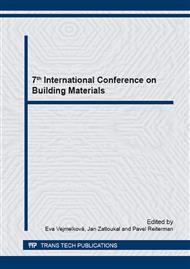[1]
Ebbrecht, T., Weyershausen, B., Lipinski, T. R., Strohm, H.: A Novel high Performance Binder for Refractories, UITECR, (2007).
Google Scholar
[2]
A. Navrotsky Thermochemical insights into refractory ceramic materials based on oxides with large tetravalent cations, Journal of Materials Chemistry 15 (2005) 1883-1890.
DOI: 10.1039/b417143h
Google Scholar
[3]
http: /www. lafarge. com/02182009-group-lafarge_timeline-uk. html.
Google Scholar
[4]
Refractories, May–June, 1984, Volume 25/5-6, pp.293-296, Production of high- lumina cement clinker by fusion in an electric furnace.
Google Scholar
[5]
Matoušek, M., Drochytka, R.: Atmospheric corrosion of concrete, ISBN 80-902558-0-9, (1998).
Google Scholar
[6]
Soro, J., Smith, A., Gault, Ch., Processing by tape casting and mechanical behaviour of aluminous cement-based matrix alumina fibers composites, Journal of the European Ceramic Society 27 (2007) 1469-1474.
DOI: 10.1016/j.jeurceramsoc.2006.05.077
Google Scholar
[7]
Kurdowski, W.: Cement and Concrete Chemistry, 2014, ISBN 987-97-007-7911-0.
Google Scholar
[8]
Nilforoushan, M., R., Et al. Correlations of Unhydrous Phases Present in Calcium Aluminate Cement with its Workability, Refractories Application and News 11/1 (2006) p.17.
Google Scholar
[9]
Nilforoushan, M. R., Talebian, N.: The Hydration Products of a refractory Calcium Aluminate Cement at Low Temperatures, Iranian Journal Chemistry Chemical Engineering 26/2 (2007).
Google Scholar
[10]
Midgley, H., Midgley, A.: The conversion of high alumina cement, Magazine of Concrete Research 27 (1975) 59-77.
DOI: 10.1680/macr.1975.27.91.59
Google Scholar
[11]
Rambo, D.A.S., Silva, F.A., Filho, R.D.T., Gomes, O.F. M, Effect of elevated temperatures on the mechanical behaviour of basalt textile reinforced refractory concrete, Mat. and Design 65 (2015) 24-33.
DOI: 10.1016/j.matdes.2014.08.060
Google Scholar
[12]
George C. M.: Structure and Performance of Cements. In: Barnes, P. (ed. ) p.415, Appl. Science Publ., London (1983).
Google Scholar
[13]
Tvarog, M., Fornůsek, J., 2014, Influence of Casting Direction on the Mechanical Properties of Cementitious Fiber Reinforced Composites, Advanced Material Research Vol. 982, pp.32-37.
DOI: 10.4028/www.scientific.net/amr.982.32
Google Scholar
[14]
Vejmelková, E., Keppert, M., Rovnaníková, P., Ondráček, M., Keršner, Z., Černý, R., Properties of high performance concrete containing fine-ground ceramics as supplementary cementitious material, Cement & Concrete Composites 34 (2012) 55-61.
DOI: 10.1016/j.cemconcomp.2011.09.018
Google Scholar
[15]
Reiterman, P., Holčapek, O., Vogel, F., Jogl, M., Koťátková, J., 2014, Fracture and mechanical properties of fire resistant fibre composites containing fine ground ceramic powder, Advanced Materials Research, Vol. 897, pp.192-195.
DOI: 10.4028/www.scientific.net/amr.897.192
Google Scholar
[16]
Holčapek, O., Reiterman, P., Konvalinka, P., 2014, Mechanical and Rheological Properties of Aluminous Cement under High Temperatures, Advanced Material Research, Vol. 982, pp.141-144.
DOI: 10.4028/www.scientific.net/amr.982.141
Google Scholar
[17]
Koňáková, D., Špedlová, V., Čáchová M., Vejmelková, E., Černý, R., 2014, Influence of Basalt Fibres and Aggregates on the Thermal Expansion of Cement-based Composites, Advanced Materials Research, Vol. 1054, pp.17-21.
DOI: 10.4028/www.scientific.net/amr.1054.17
Google Scholar
[18]
Jogl, M., Reiterman, P., Holčapek, O., Koťátková, J., 2014, Proposal of Fire Resistant Composites with Application of Lightweight Aggregate Liaver, Advanced Materials Research, Vol. 1054, pp.43-47.
DOI: 10.4028/www.scientific.net/amr.1054.43
Google Scholar
[19]
Reiterman, P., Jogl, M., Baumelt, V., Seifrt, J., 2014, Development and Mix design of HPC and UHPFRC, Advanced Material Research, Vol. 982, pp.130-135.
DOI: 10.4028/www.scientific.net/amr.982.130
Google Scholar


